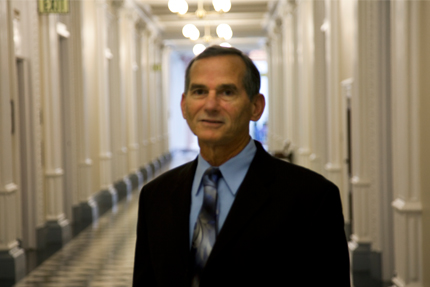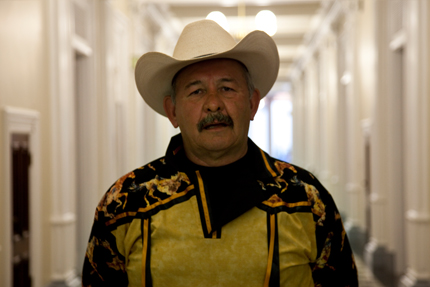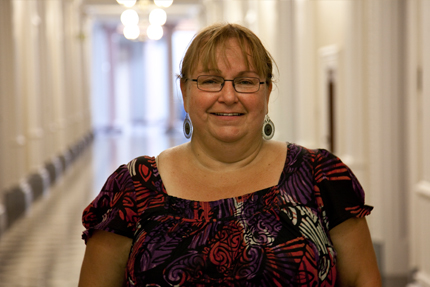Related Rural Blog Posts
Bringing Practical Biomass Energy to Rural Communities
Posted by on July 22, 2011 at 10:28 AM EDTEd. Note: Champions of Change is a weekly initiative to highlight Americans who are making an impact in their communities and helping our country rise to meet the many challenges of the 21st century.

The second generation of bioenergy crops has the potential to produce more energy on poorer soils and with fewer inputs than any crops we use for energy now. But turning this potential into practical, profitable crops may only come when farmers have had a chance to work with them.
Selecting the most promising crops from research conducted at the University of Illinois and drawing on the experience of the farmers we visited in Germany and Austria, we found that the economics and logistics of biomass production and its use on our farm and in our community looked very promising. The holdup is a “chicken or egg” situation. No farmer wants to plant a new crop without a market, and new markets won’t develop without a supply.
In Europe we also learned how even small amounts of biomass can be effectively used to replace oil, coal, and gas to heat homes, farm buildings, schools, and businesses. As supplies of biomass increase, power plants and even cellulosic ethanol plants can be considered; however, using locally produced biomass will, in most instances, prove to be beneficial to producers and end users alike, thus strengthening the community.
Billions of dollars (both private and public) are being spent to learn how to convert biomass to liquid fuels. Yet, unless we provide the incentive to establish biomass crops, we won’t have them when we need them. It would be akin to spending billions to research and build a new fighter jet and then realizing that we have no fuel to fly it.
Learn more about Energy and Environment, RuralEmpowering Farm Women to be Better Business Partners
Posted by on July 21, 2011 at 7:27 PM EDTEd. Note: Champions of Change is a weekly initiative to highlight Americans who are making an impact in their communities and helping our country rise to meet the many challenges of the 21st century.

Truly an inspiring event on July 6, 2011, starting with a tour of the East Wing of the White House and then on to the White House Champions of Change roundtable. Wonderful and talented people working in rural areas around the country, and then another high point: President Obama entered the room. Not only was this the first time in my life that I was in the same room with a sitting President, but I also was able to shake hands and make eye contact with the person holding the most powerful office on earth. It is an honor to be recognized by this level of my government.
What brought me to the Rural Champions of Change roundtable event is a program that I created called Annie's Project—Education for Farm Women. The mission of Annie’s Project is to empower farm women to be better business partners through networks and by managing and organizing critical information. I started this program with 10 women in February 2008 at a local community college, Kaskaskia College in Centralia, IL. The program’s funding came from USDA’s Risk Management Agency, which provides grants to assist underserved audiences.
Long story short, and eight years later, over 8,000 women have benefited from attending an educational program based on the life of my mother, Annette Kohlhagen Fleck. Her friends called her Annie. Annie was married to a farmer for 50 years and she truly loved living and working on the farm. A small town girl in northern Illinois, she lived her dreams and raised her family of four children on a dairy and poultry farm. My life experience of growing up on the farm observing all that she contributed, and then my work with University of Illinois Extension for 30 years, gave me a perspective of what farm women need in the way of education, support and networking.
Removing Barriers to Successful Agriculture in Indian Country
Posted by on July 21, 2011 at 5:57 PM EDTEd. Note: Champions of Change is a weekly initiative to highlight Americans who are making an impact in their communities and helping our country rise to meet the many challenges of the 21st century.

Being a part of the White House “Champions of Change” is both an honor and humbling experience. It was an honor to be in the presence of the President and humbling as there are thousands out there who have accomplished more for their communities than me.
I began work for the Intertribal Agriculture Council (IAC) 20 years ago as a Natural Resource Director which entailed the identification and solutions to regulatory barriers presented by both the Department of Agriculture and Department of Interior. In 1998, I was promoted to Director of Programs and assigned the responsibility of the day to day supervision of the 11 employees. The individual who played the leadership role in bringing about the formation of the IAC had to resign for medical reasons in 2001 and the Board of Directors selected me to fulfill the role of Executive Director.
The IAC Board of Directors is comprised of individual Board Members who represent one of the 12 regions of Indian Country, and it is the Board of Directors that set the priorities for the overall direction of the organization as well as assign tasks to the Executive Director. For this reason, I believe that each of our Directors should play a role in the recognition of the Intertribal Agricultural Council.
IAC was founded in 1987 by order of Congress to pursue and promote the conservation, development and use of Indian Country agricultural resources for the betterment of Native American people. Land-based agricultural resources are vital to the economic and social welfare of many Native American and Alaskan Tribes. The harmonies of man, soil, water, air, vegetation and wildlife that collectively make-up the American Indian agriculture community, influence our emotional and spiritual well-being. Prior to 1987, American Indian agriculture was basically unheard of outside reservation boundaries.
Learn more about RuralSupporting Regionally Grown Food
Posted by on July 21, 2011 at 4:12 PM EDTEd. Note: Champions of Change is a weekly initiative to highlight Americans who are making an impact in their communities and helping our country rise to meet the many challenges of the 21st century.

At the Rural Champions of Change roundtable, I had a chance to tell President Obama about FoodHub – a dynamic online marketplace that helps regional food buyers and sellers find each other, connect and conduct business. When I likened it to a matchmaking service, President Obama laughed and called FoodHub “a great idea.” Certainly in the context of rural development, he’s right.
Consider the following scenario: Susan Barker, the school food service director at Beaverton Public Schools, wants to bring more locally produced food into the school lunchroom. Knowing that berries are plentiful in the Northwest, she’d like to buy blueberries from a local farm. Before FoodHub she’d have been at a loss, not knowing where to begin.
But because FoodHub exists, Barker walks to her computer, pulls up the FoodHub website and types in the word “blueberry.” Up pops a list of the twenty blueberry producers registered in FoodHub. Because Barker is serving 22,000 meals a day, she narrows her results to only those large enough to meet her volume needs. Now she has two choices. She can peruse the profiles of producers whose products are available through regional mainline distributors or she can select a producer with capacity for direct sales and delivery.
Learn more about RuralA Bright Future for Farming and Ranching
Posted by on July 21, 2011 at 9:04 AM EDTEd. Note: Champions of Change is a weekly initiative to highlight Americans who are making an impact in their communities and helping our country rise to meet the many challenges of the 21st century.

Farming and ranching has a bright future, provided that we maintain competition in the marketplace for our products grown in rural America. Access to broadband internet with as fast of speed available in New York City, should also be accessible on mainstreet of our small towns. Entrepreneurs and business people could “tele-commute” from our rural communitites with their counterparts throughout the world. Healthcare would also break down barriers through “tele-medicine” with broadband hot-spots in these small towns.
We are fortunate to have a very “producer-driven” United States Department of Agriculture (USDA). This was confirmed during our roundtable discussion with Secretary Tom Vilsack. The Secretary has a “hands-on” mentality to manage the various programs and agencies under the umbrella of the USDA. I was impressed with the Secretary’s personal approach to answering our questions and responding to feedback on how we appreciate the Department and on possible improvements. Places and people affected is the mission of the USDA in working with the Domestic Policy council in order to ensure that support for our rural communities is accomplished.
Competition for our livestock industry is extremely important to maintain producer confidence. USDA has been working on finalizing rules through GIPSA that ensure the rights of independent livestock producers are protected. In South Dakota nearly all of our feeder cattle are sold through a local livestock auction market. When I sell my cattle at an auction market my neighbors and order-buyers from around the Country have the chance to pay the top-dollar for my cattle. I applaud the USDA for working towards strengthening this marketing aspect of our farm and ranch operations.
Learn more about RuralReaching Out to Rural Communities
Posted by on July 21, 2011 at 7:00 AM EDTEd. Note: Champions of Change is a weekly initiative to highlight Americans who are making an impact in their communities and helping our country rise to meet the many challenges of the 21st century.

This past Wednesday, July 6, 2011, I was honored as a Champion of Change, allowing me to join with other rural community representatives, Secretary of Agriculture, and White House officials.
There were representatives from farms, tribal communities, community colleges, small businesses, and even a bio fuel producer. We had a round table discussion of what each had done in their community and policy recommendations for improvements in rural communities. These recommendations included simplifying grants, expanding available credit, and to expanding educational opportunities in rural communities.
As a Town Manager of a small rural town I know the difficulties faced in our small communities. Our communities’ infrastructures are at their life expectancy and we are faced with the cost of replacement. I was nominated because of the challenging and innovative work I did with the USDA in refinancing an old debt and getting more grant than loan monies for my communities’ Wastewater Improvement Project. I have also worked with the CDBG, EDA, Otted, and other local and state grants for wastewater, water, roads, and sidewalk improvements. There is much more to be done.
Learn more about Rural
- &lsaquo previous
- …
- 20
- 21
- 22
- 23
- 24
- 25
- 26
- 27
- 28
- …
- next &rsaquo